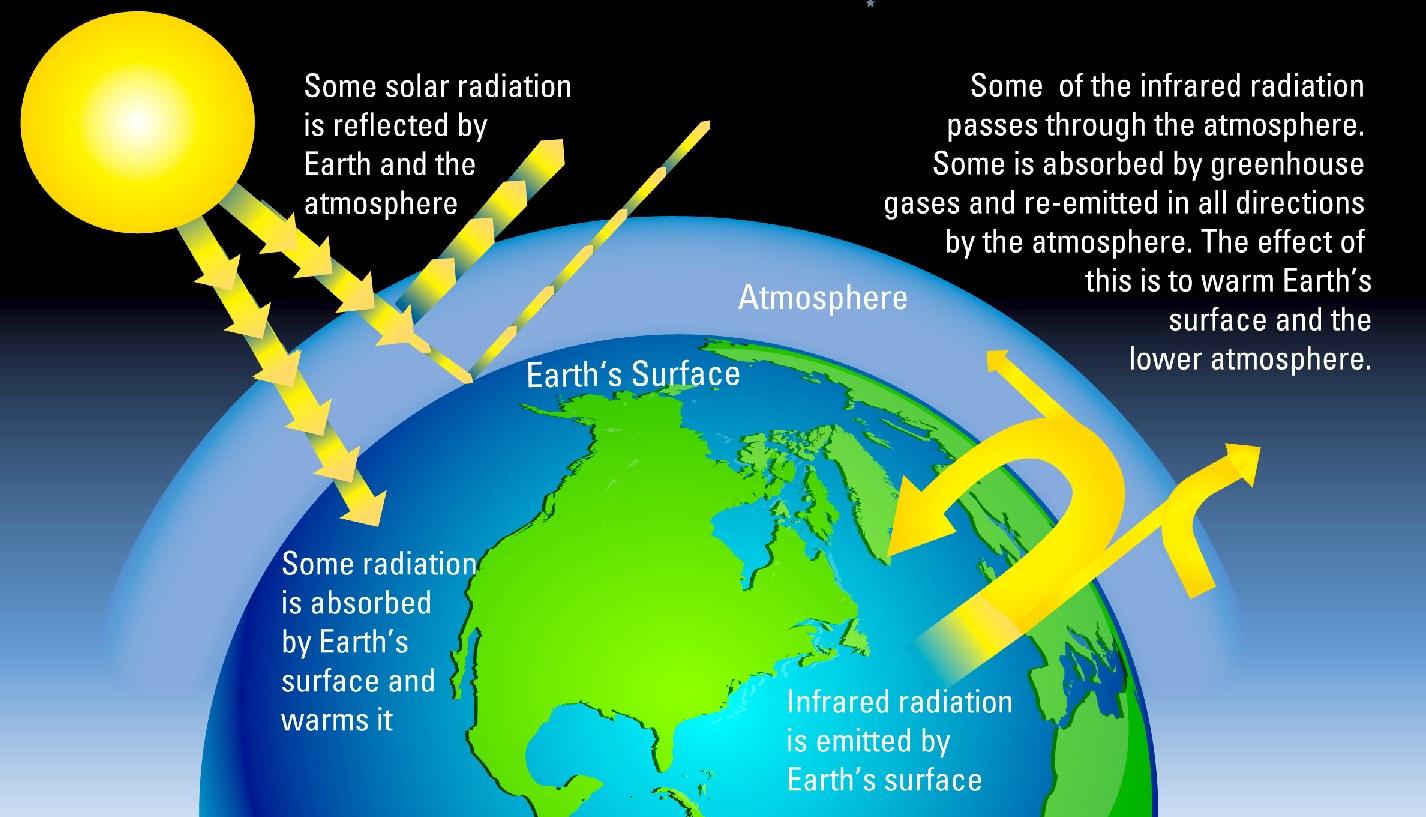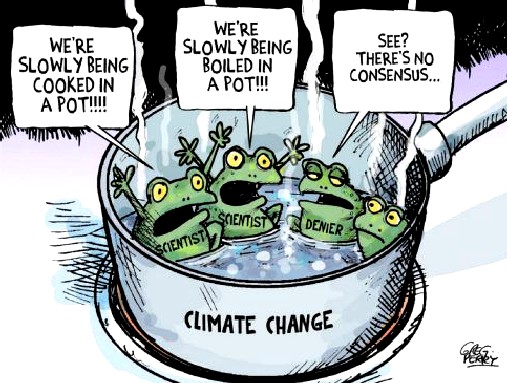|
CARBON
MONOXIDE
Pleas use our
A-Z INDEX to
navigate this site

JUST
LIKE A GLASS BOWL -
Radiation from the sun would be reflected out into space, but
with more greenhouse gases in the atmosphere some radiated
heat is absorbed and re-emitted back to earth just as if we
lived in a greenhouse.
Carbon monoxide (chemical formula CO) is a colorless, odorless, tasteless, flammable gas that is slightly less dense than air. Carbon monoxide consists of one carbon atom and one
oxygen atom. It is the simplest molecule of the oxocarbon family.
Thermal combustion is the most common source of carbon monoxide, however there are numerous environmental and biological sources that generate and emit a significant amount of carbon monoxide. Carbon monoxide is an important in the production of many compounds ranging from drugs, fragrances, and fuels. It is produced by many organisms, including humans.
Carbon monoxide has important biological roles across phylogenetic kingdoms. In mammalian physiology, carbon monoxide is a classical example of hormesis where low concentrations serve as an endogenous neurotransmitter (gasotransmitter) and high concentrations are toxic resulting in carbon monoxide poisoning. It is isoelectronic with cyanide.

AIR POLLUTION AND CLIMATE CHANGE
Carbon monoxide is a temporary atmospheric pollutant in some urban areas, chiefly from the exhaust of
internal combustion engines (including vehicles, portable and back-up generators, lawnmowers, power washers, etc.), but also from incomplete combustion of various other fuels (including
wood, coal, charcoal, oil, paraffin, propane, natural gas, and trash).
Large CO pollution events can be observed from space over cities. Carbon monoxide is, along with aldehydes, part of the series of cycles of chemical reactions that form photochemical smog.
Carbon monoxide has an indirect effect on radiative forcing by elevating concentrations of direct greenhouse gases, including methane and tropospheric ozone. CO can react chemically with other atmospheric constituents (primarily the hydroxyl radical, OH.) that would otherwise destroy methane. Through natural processes in the atmosphere, it is oxidized to carbon dioxide and
ozone. Carbon monoxide is short-lived in the atmosphere (with an average lifetime of about one to two months), and spatially variable in concentration.
AIR POLLUTION, LUNG CANCER AND HUMAN DEATHS
A review of evidence regarding whether ambient air pollution exposure is a risk factor for cancer in 2007 found solid data to conclude that long-term exposure to PM2.5 (fine particulates) increases the overall risk of non-accidental mortality by 6% per a 10 microg/m3 increase. Exposure to PM2.5 was also associated with an increased risk of mortality from lung cancer (range: 15% to 21% per 10 microg/m3 increase) and total cardiovascular mortality (range: 12% to 14% per a 10 microg/m3 increase). The review further noted that living close to busy traffic appears to be associated with elevated risks of these three outcomes – increase in lung cancer deaths, cardiovascular deaths, and overall non-accidental deaths. The reviewers also found suggestive evidence that exposure to PM2.5 is positively associated with mortality from coronary heart diseases and exposure to
SO2 increases mortality from
lung
cancer, but the data was insufficient to provide solid
conclusions.
Another investigation showed that higher activity level increases deposition fraction of aerosol particles in human lung and recommended avoiding heavy activities like running in outdoor space at polluted areas.
In 2011, a large Danish epidemiological study found an increased risk of lung cancer for patients who lived in areas with high
nitrogen oxide concentrations. In this study, the association was higher for non-smokers than smokers. An additional Danish study, also in 2011, likewise noted evidence of possible associations between air pollution and other forms of
cancer, including cervical cancer and brain cancer.
In the United States, despite the passage of the Clean Air Act in 1970, in 2002 at least 146 million Americans were living in non-attainment
areas - regions in which the concentration of certain air pollutants exceeded federal standards. These dangerous pollutants are known as the criteria pollutants, and include ozone, particulate matter, sulfur dioxide,
nitrogen dioxide, carbon monoxide, and lead.
Protective measures to ensure children's health are being taken in cities such as New Delhi,
India where
buses now use
compressed natural gas to help eliminate the "pea-soup"
smog. A recent study in Europe has found that exposure to ultrafine particles can increase blood pressure in children. According to a WHO report in 2018, polluted air leads to the poisoning of millions of children under the age of 15, resulting in the death of some six hundred thousand children annually.
The United Kingdom suffered its worst air pollution event when the 4 December Great Smog of 1952 formed over
London. In six days more than 4,000 died and more recent estimates put the figure at nearer 12,000.

THE
CAUSES IN SECTORS -
Transportation and energy for living are the main causes of
greenhouse gas build up in the atmosphere as carbon dioxide
and nitrous oxides, with agriculture loading us with methane
and more nitrous oxides. Hence, we need to revise our eating
habits and switch to renewable energy for our cars and
industry as quickly as possible.
CARBON MONOXIDE POISONING
We all know the carbon monoxide poisoning can have deadly consequences. Did you know that your carbon monoxide (CO) detector in your home may only alert you if the carbon monoxide in your home reaches dangerous levels? Headaches, dizziness, fatigue and nausea are common symptoms to look out for especially if multiple household members are experiencing this. Symptoms can vary from person to person and they may not experience all of the common symptoms.
Carbon monoxide is produced when fuel is burned. Gas furnaces, boilers fireplaces, water heaters and stoves are the usual culprits when CO is present in the home. Properly maintaining and getting annual service by a professional on your HVAC system and
water heater will ensure that dangerous fumes won’t be released into your home from these systems.
Because carbon monoxide interferes with the body’s ability to transport and use oxygen, long-term exposure to low levels that may not set off your CO detector can cause heart disease, arterial issues and neurological problems. For the health and safety of your family, have your furnace and water heater professionally inspected annually to help prevent carbon monoxide poisoning in your home.

SOURCES
Carbon monoxide (CO) is a common, potentially lethal gas produced by the incomplete combustion of fossil fuels such as natural or liquefied
petroleum gas, oil, wood, and coal, It is one of the oldest documented toxicants, You may be exposed to carbon monoxide by using poorly maintained or unvented heating equipment, improperly vented natural gas appliances like stoves or water heaters & running vehicles.
The industrial processes where carbon monoxide may be produced include metal manufacturing, the
electricity supply, mining metal ore and coal, food manufacturing, extracting oil and gas from land or sea, The production of chemicals, cement lime, plaster and concrete manufacturing, and
petroleum refining.
Industrial plants emit carbon monoxide through the combustion of natural gas, coal and coke too, There are many other sources of carbon monoxide include the
internal combustion engines of chainsaws and leaf blowers, as well as charcoal heaters, such as barbeques, wood stoves, gas water heaters, gas stoves, fuel-fired heaters, fireplaces, and gas dryers.
Carbon monoxide can occur naturally in the environment, It is released into the atmosphere by volcanoes as they erupt, from the smoke of
forest
fires, from the natural gases in coal mines, and from lightning, Other natural sources of carbon monoxide are marsh gases, which are called
methane and produced by plants decomposing underwater,
marine
algae, kelp & seed germination growth.
Carbon monoxide is a major component of motor vehicle exhaust fumes, It is emitted into the atmosphere by
cars,
trucks,
boats & aeroplanes, Vehicle exhaust fumes and bushfires are the highest emitters of carbon monoxide, People and animals can be exposed to high levels of carbon monoxide during
bushfires.
You may be exposed to unsafe levels of carbon monoxide by running generators or gas-powered tools or vents, cooking with a charcoal or gas grill, using a propane camp stove, When carbon monoxide is emitted into the atmosphere, it affects the amount of greenhouse gases which are linked to climate change and
global
warming, This means that land and sea temperature increases changing to ecosystems, increasing storm activity and causing other extreme weather events.
People are exposed to carbon monoxide by breathing in contaminated air, Using equipment that has not been maintained, or is not working properly, Smoking, or breathing of other people’s
cigarette
smoke, Living near industries that emit carbon monoxide, or near freeways and busy roads, Using
non-electric heaters, like wood heaters, Working in a job where carbon monoxide is produced or used.
WHO IS MOST AT RISK
The people are at risk of CO poisoning, Unborn babies, infants, the elderly, and people with chronic heart disease, anemia, or respiratory problems are generally more at risk than others, Breathing CO can cause a headache, dizziness, vomiting, and nausea, If carbon monoxide levels are high enough, you may become unconscious or die.
Carbon monoxide is a toxic component of industrial emissions, exhaust and cigarette smoke, carbon monoxide starves our cells of oxygen by replacing oxygen molecules in the
blood, Exposure to carbon monoxide can have fatal consequences, when blood vessels are blocked, such as during heart attack or stroke.

TREES
FOR HUMAN BREATHING
-
On average, one tree produces nearly 260 pounds of oxygen each year or 118 kilograms.
A human breathes about 9.5 tonnes of air in a year, about 23 percent of that is oxygen, by mass. We extract a little over a third of the oxygen from each breath. That works out to a total of about 740kg of
oxygen per year. Which is, very roughly, six or seven trees’ worth.
A mature sycamore tree might be around 12m tall and weigh two tonnes, including the roots and leaves. If it grows by five per cent each year, it will produce around 100kg of wood, of which 38kg will be carbon. Allowing for the relative molecular weights of oxygen and carbon, this equates to 100kg of oxygen per tree per year.
MONOXIDE AND DIOXIDE - DIFFERENCES
Carbon monoxide (CO) and carbon dioxide (CO2) are two different gases, Both gases are a combination of carbon and oxygen, When combustion of carbon is complete, which requires the presence of sufficient oxygen (plenty of air) the result is carbon dioxide, The combustion refers to “the chemical combination of the substance with oxygen” and does not always, but sometimes, involve fire and flames.
When the combustion of carbon is incomplete, which happens when there is a limited supply of air, only half oxygen adds to the carbon and instead carbon monoxide is formed, packaged carbon monoxide is used in many industries including metal fabrication, in the manufacture of chemicals, for the reduction of ores in the manufacture of metal carbonyls, in the pharmaceutical industry and in
electronic and semiconductor applications.
The “incomplete” combustion of coal, natural gas, and
oil is a known environmental source of carbon monoxide, Low levels of oxygen & low temperatures cause the formation of higher percentages of CO in the combustion mixture, The
internal combustion engine is the main source of workplace exposure to carbon monoxide in industrial settings, Many furnaces & ovens produce large amounts of the gas, especially when they are not properly maintained.
Carbon dioxide gas is produced during some fermentation processes such as wine-making, Natural sources account for the majority of CO2 released into the atmosphere, These include oceans, animal (and human) and plant respiration, decomposition of the organic matter, the
forest fires, & emissions from volcanic eruptions.
The industrial plants that produce hydrogen or ammonia from natural
gas, coal, or large-volume fermentation operations where plant products are made into ethanol, are some of the largest commercial producers of carbon dioxide gas.
If you’re exposed to CO for too long, you’ll die from asphyxiation (lack of oxygen).

SYMPTOMS
OF CARBON MONOXIDE POISONING
The most common symptoms of CO poisoning, according to the CDC include:
-
Headache
- Dizziness
- Weakness
- Nausea
- Vomiting
- Chest pain
- Confusion
It’s hard to diagnose carbon monoxide poisoning because it mimics other problems you might be having.
CAUSES OF CARBON MONOXIDE IN YOUR HOME
You produce CO whenever you burn fuels like natural gas, oil, wood or
kerosene, This, of course means, CO comes from:
- Furnaces
- Fireplaces
- Wood stoves
- The vehicles in your garage
- Space heaters

AGRICULTURE
In India in 2014, it was reported that air pollution by black carbon and ground level ozone had reduced crop yields in the most affected areas by almost half in 2011 when compared to 1980 levels.
ECONOMY AND WORLD HEALTH
Air pollution costs the world economy $5 trillion per year as a result of productivity losses and degraded quality of life, according to a joint study by the
World Bank and the Institute for Health Metrics and Evaluation (IHME) at the University of Washington. These productivity losses are caused by deaths due to diseases caused by air pollution. One out of ten deaths in 2013 was caused by diseases associated with air pollution and the problem is getting worse.
The problem is even more acute in the developing world. "Children under age 5 in lower-income countries are more than 60 times as likely to die from exposure to air
pollution as children in high-income countries." The report states that additional economic losses caused by air pollution, including health costs and the adverse effect on
agricultural and other productivity were not calculated in the report, and thus the actual costs to the world economy are far higher than $5 trillion.
CLIMATE CHANGE
Because a large share of air pollution is caused by combustion of
fossil fuels such as
coal and oil, the reduction of these fuels can reduce air pollution drastically. Most effective is the switch to clean power sources such as wind power, solar power, hydro power which don't cause air pollution. Efforts to reduce pollution from mobile sources includes expanding regulation to new sources (such as
cruise and
transport ships, farm equipment, and small gas-powered equipment such as string trimmers, chainsaws, and snowmobiles), increased fuel efficiency (such as through the use of
hybrid
vehicles), conversion to cleaner fuels, and conversion to electric
vehicles.
A very effective means to reduce air pollution is the transition to
renewable
energy. According to a study published in Energy and Environmental Science in 2015 the switch to 100%
renewable energy in the United States would eliminate about 62,000 premature mortalities per year and about 42,000 in 2050, if no biomass were used. This would save about $600
billion in health costs a year due to reduced air pollution in 2050, or about 3.6% of the 2014 U.S. gross domestic product. Air quality improvement is a near-term benefit among the many societal benefits from
climate change mitigation.
There is limited evidence that efforts to reduce particulate matter in the air can result in better health in
Africa, the
Middle
East, Eastern Europe, Central Asia, and Southeast Asia.
LINKS
& REFERENCE
https://www

Pleas use our
A-Z INDEX to
navigate this site
This
website is provided on a free basis as a public information service.
copyright © Climate Change Trust 2019. Solar
Studios, BN271RF, United Kingdom.
|






